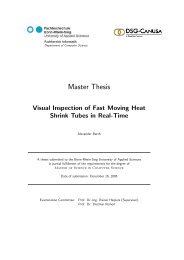Master Thesis - Hochschule Bonn-Rhein-Sieg
Master Thesis - Hochschule Bonn-Rhein-Sieg
Master Thesis - Hochschule Bonn-Rhein-Sieg
Create successful ePaper yourself
Turn your PDF publications into a flip-book with our unique Google optimized e-Paper software.
5. Algorithms <strong>Master</strong> <strong>Thesis</strong> Björn Ostermann page 98 of 126<br />
a) b)<br />
current<br />
Dynamic objects<br />
Robot<br />
goal<br />
current<br />
c) d)<br />
current<br />
current<br />
Dynamic objects<br />
Robot<br />
goal<br />
e) f)<br />
current<br />
Dynamic objects<br />
goal<br />
current<br />
Robot<br />
Robot<br />
Dynamic objects<br />
Dynamic objects<br />
Dynamic objects<br />
Robot<br />
Robot<br />
Figure 71: Graphical explanation of the calculation of the shortest evasion path<br />
The calculations that lead to the results depicted by the images are:<br />
- A straight line is drawn from the first to the last point (Figure 71a)<br />
- The next point is checked, whether it is “below” the first line (closer to the robot) and if so it is<br />
set as the start-pixel for the current line. (Figure 71b)<br />
- Step one and two are repeated, until no more pixels are below the current line (Figure 71c).<br />
- The current line is stored and a new line is begun.<br />
- The new line is drawn from the fist pixel to the start of the recently stored line (Figure 71d).<br />
- Step one and two are repeated, until no more pixels are below the new line (Figure 71e).<br />
- Again, a new line is drawn from the first pixel to the start of the recently stored line (Figure 71f).<br />
The algorithm is finished, if the stored line begins in the first pixel.<br />
A flowchart, showing the complete algorithm, is shown in Figure 72.<br />
goal<br />
goal<br />
goal














